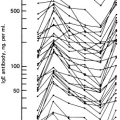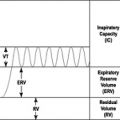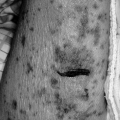Management of the Psychologically Complicated Patient
Michael S. Ziffra
Jackie K. Gollan
Psychiatric and psychosocial issues complicate management of medical illness, with allergic diseases being no exception. The presence of concurrent psychiatric diagnoses or more enduring maladaptive personality traits can interfere with the physician–patient relationship and patient adherence to medical care. Even normal, expected reactions to acute and chronic medical illness can create distress and hinder care.
Who is the psychologically complicated patient? This term can apply to patients with a significant psychiatric illness, such as depression, bipolar disorder, or anxiety disorder. This term may also refer to individuals with problems such as substance overuse, personality disorders, and nonadherence with medical treatment. Physicians treating such patients must invest greater-than-usual amounts of time and effort to optimally manage their medical and psychiatric issues.
Balancing concurrent psychiatric and allergic diseases is challenging for patients and their health care providers. Many physicians feel they do not have sufficient experience and skill to manage these types of issues, potentially making them feel powerless or guilty about their inability to help the patient. It is essential, therefore, that all physicians develop a basic understanding of major psychiatric illnesses and clinically relevant psychosocial issues. Being able to work with psychiatrically complicated patients in an empathic manner not only leads to more compassionate care, but also enhances effective management of the primary medical diagnosis.
This chapter will highlight the clinical advances in treating individuals with allergies and comorbid psychiatric conditions, with discussion of common psychiatric disorders, treatment approaches, and clinical challenges requiring attention to promote clinical effectiveness. Common psychiatric diagnoses and other psychosocial barriers to care will first be outlined, followed by a discussion of effective, evidence-based treatments and their practical administration.
Mood Disorders
According to the Diagnostic and Statistical Manual of Mental Disorders (DSM-IV) (1), a major depressive episode is defined as a period lasting 2 weeks or more of predominantly depressed mood, accompanied by other symptoms (see Table 43.1). The diagnosis of major depressive disorder (MDD) is given to an individual who has had one or more major depressive episodes (and does not meet diagnostic criteria for bipolar disorder). A devastating and recurrent disease, MDD will emerge as the second leading cause of worldwide disability by 2020 (2). Up to 20% of the general population is expected to experience major depression at least once during their lifetime. These statistics may underestimate the true prevalence of depression, since symptom complaints are often disregarded or misdiagnosed, particularly among primary care and geriatric populations (3). Also, depression recurs over the lifespan (4). Specifically, the Agency for Health Care Policy and Research has noted that the risk of recurrence increases exponentially with each successive episode. Even after treatment, 40% of patients with a history of three or more depressive episodes are likely to relapse within 7 weeks after recovery (5). Given the prevalence and chronicity of depression, innumerable people face the prospect of a lifetime struggle with depression.
Table 43.1 Symptoms of Major Depression | ||
|---|---|---|
|
MDD is more prevalent among individuals with many types of chronic illness, including hypertension, congestive heart failure, diabetes mellitus, coronary artery disease, chronic obstructive pulmonary disease, stroke, and end-stage renal disease. Depression in chronic illness has been associated with greater
symptom burden and functional impairment, higher rates of morbidity and mortality, and decreased treatment adherence. It also results in decreased productivity and greater health resource utilization (6,7).
symptom burden and functional impairment, higher rates of morbidity and mortality, and decreased treatment adherence. It also results in decreased productivity and greater health resource utilization (6,7).
A significant association between depression and allergic disorders has been observed. Depressed patients have higher rates of atopic illness than nondepressed individuals (8–10). Meanwhile, allergic disease may increase the risk for depression threefold (8). Psychiatric disorders are more prevalent in patients with asthma and other allergic diseases. Also, evidence has shown a correlation between the severity of depressive symptoms and that of allergic symptoms (9).
The reasons for this relationship are not completely understood and are likely very complex. Depression is associated with changes in functioning of the immune system, which could predispose individuals to atopic illness. Cytokines, leukotrienes, and other substances released during allergic reactions may have effects on neurotransmitter activity involved in the regulation of mood. Dysfunction of the hypothalamic-pituitary-adrenal axis and alterations in fatty acid metabolism are believed to occur in both depression and allergic disease (8–10). Interestingly, twin studies have suggested that the two types of illness may have a common genetic cause (8– 10). Thus, the higher prevalence of depression in patients with atopic illnesses, as well as its potential effects on the severity of allergic symptoms, underscore the need for allergist-immunologists to recognize depressive disorders in their patients to ensure they receive appropriate treatment (11).
Bipolar disorder is another serious mood disorder associated with significant disability. It is characterized by the presence of both major depressive episodes and episodes of mania or hypomania. Mania is defined as a period of excessively elevated or excited mood, typically accompanied by increased energy, anger, irritability, and impulsivity. Key signs and symptoms of mania are listed in Table 43.2. Hypomanic episodes are characterized by these same symptoms, but they are less severe and shorter in duration.
Table 43.2 Symptoms of Mania | ||
|---|---|---|
|
Though mood disorders can be quite disabling, they are also treatable. For this reason, it is important that treatment be initiated as soon as the disorder is identified, and sustained until remission is achieved. Increasingly, primary care physicians and other nonpsychiatrists are treating depression in their patients, typically by prescribing antidepressant medications. This practice is reasonable for patients who are reluctant to accept a referral to a mental health specialist and whose depression is not severe.
Patients with symptoms indicative of severe depression are best referred to a psychiatrist. Such symptoms include active suicidal ideation, psychotic symptoms such as hallucinations and delusions, prominent agitation or volatility, and significant decline in functioning. Other situations that warrant psychiatric consultation include treatment-resistant depression (which can be defined as failure to adequately respond to three or more antidepressants), suspicion for bipolar disorder, complicated psychiatric comorbidity, complex psychopharmacologic regimens, and concomitant substance abuse (12).
Psychotherapy is beneficial in the treatment of mood disorders, and it can be effective as the sole treatment for depressive episodes of mild-to-moderate severity. There are empirical data supporting the use of some types of psychotherapy, including cognitive-behavioral therapy and interpersonal therapy, in the treatment of depression. More severe depressions typically require a combination of concurrent psychotherapy and medication.
Bipolar disorder is best managed by mental health specialists, given the complex nature of the disease and the medications used to treat it. A variety of pharmacologic agents are used to treat bipolar disorder, including lithium, mood-stabilizing anticonvulsants, antipsychotics, and antianxiety medications.
Psychotherapy is also a key component of bipolar disorder treatment.
Psychotherapy is also a key component of bipolar disorder treatment.
Anxiety Disorders
Anxiety disorders are also frequently encountered in general and specialty medical practices. Like depression, anxiety disorders are highly comorbid with many types of medical illness, and they are associated with higher rates of morbidity and mortality, health care utilization, and functional disability (13). Several distinct anxiety disorders have been described in the medical literature. Among these are social phobia, an excessive fear of being scrutinized or embarrassed in social situations; obsessive-compulsive disorder, characterized by recurrent, intrusive thoughts and/or rituals and repetitive behaviors; and post-traumatic stress disorder (PTSD), in which individuals experience a number of anxiety symptoms following a life-threatening trauma (1).
There are two anxiety disorders, panic disorder and generalized anxiety disorder (GAD), that merit particular mention, given their high prevalence and the frequency with which they are encountered by nonpsychiatrists. A panic attack is an episode of intense anxiety that develops and resolves over a brief period of time and is accompanied by a number of somatic and psychologic symptoms. These symptoms can include palpitations, chest pain, shortness of breath, nausea, trembling, dizziness, and paresthesias. Because panic attacks are characterized by intense fear and uncomfortable physical symptoms, individuals in the midst of an attack may worry that they are having a heart attack or even close to dying. This may lead to their seeking medical attention (14).
Panic attacks can occur as part of many anxiety disorders. Panic disorder is specifically defined as a pattern of recurrent, unexpected panic attacks. This is accompanied by at least 1 month of the patient worrying about future attacks or changing his or her behavior because of the attacks. Panic attacks can be accompanied by agoraphobia, which is a fear of places in which escape or help might not be available if an attack were to occur (such as being on a bus or plane, or in a large crowd).
GAD, meanwhile, is characterized by uncontrollable worry about multiple topics, such as work, family, money, etc. This worry is accompanied by at least three additional physical or psychological symptoms, which include fatigue, sleep disturbance, muscle tension, restlessness, difficulty concentrating, and irritability. Just as with panic disorder, the presence of somatic symptoms in GAD may prompt patients to seek medical attention (15).
As is the case with depression, anxiety is often treated directly by patients’ primary care physicians, and sometimes this can be appropriate in cases of mild-to-moderate anxiety. Most antidepressants are quite effective for treating anxiety (bupropion being a notable exception), and they actually are first-line agents for most anxiety disorders. Benzodiazepines are also commonly used, often in conjunction with an antidepressant.
Many patients with anxiety disorders, however, require treatment by a mental health specialist. Examples include patients with more serious symptoms, for example, patients whose fear of panic attacks is so severe that they rarely leave their home or avoid important activities or obligations. Other situations that would necessitate psychiatric referrals include treatment-resistant anxiety, comorbid psychiatric illness, and concomitant substance abuse. Also, obsessive-compulsive disorder and PTSD are two particularly challenging diagnoses that are best treated by mental health specialists.
Psychotherapy also plays a prominent role in the management of anxiety disorders. Many anxiety disorders of mild-to-moderate severity are very amenable to treatment with psychotherapy alone. Severe or treatment-resistant anxiety disorders are often best managed through a combination of medication and psychotherapy.
Of note, a significant correlation between anxiety and allergic disorders has been described in the literature (16–19




Stay updated, free articles. Join our Telegram channel

Full access? Get Clinical Tree







